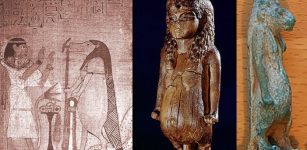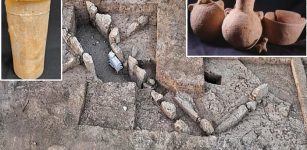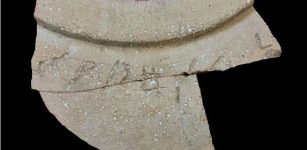Kikimora – Nightly Evil Female Spirit And Goddess Of Chickens In Slavic Beliefs
A. Sutherland - AncientPages.com - Ancient beliefs say that Kikimora spirits (there are many of them) probably live in every household. However, in some versions of her story, she usually appears in homes of dysfunctional, unhappy families where abuse, quarrel, and screams occur daily.
Swamp Kikimora, after which the spider Kikimora palustris is named. Art work by symbolist
painter Vasiliy Ivanovich Denisov (1862–1922).
Kikimora originates in Slavic folklore. In the ancient beliefs of the East Slavs, there are two different kinds of Kikimoras.
One dwells in the forest and is married to the Domovik (Domovoi). The other one comes from the swamp and is married to Leshy.
Kikimora sleeps in dark places of the home, usually in the cellar or behind the furnace, and during the nights, she comes out and works with weaving, spinning, and needlework.
If the home is well kept, Kikimora is happy with the family. She helps them with housework, guards the family members, and protects the chickens. Generally, Kikimora likes skillful and hard-working women that perform their traditional work at home.
An angry and displeased Kikimora may be a troublesome spirit for the family because she interferes in people's lives, disturbs their sleep (mainly irritating children), and makes noises by scratching and whistling at night. She also moves and throws objects, makes them disappear, or changes their places.
Appearance Of Kikimora And Her Psychic Abilities
She is an evil spirit in the form of a small woman with a thimble head, long flowing hair, chicken feet, a body as thin as a straw, and a face, which is almost human-like but shapeless. Kikimora could quickly become invisible.
Illustration of a Kikimora (1934) by Ivan Bilibin (1876-1942). (Kikimora as house-spirit and guardian of chickens - hence her depiction in chicken-like form). Image credit: Ivan Bilibin - Public Domain
Despite her small size, she is a powerful spirit with psychic abilities that help to warn her family of a disaster or dangerous enemies approaching the house where she lives. In other words, she first delivers warnings of misfortune rather than good news.
However, she can be a challenging spirit to work with and keep happy. Once Kikimora is inside the house, it is difficult to get her to leave.
To encounter Kikimora spinning was believed to be a bad omen of impending death.
Kikimora – A 'Chicken Goddess'
In the beliefs of Slavic people, Kikimora is a goddess of chickens. She guards them but sometimes torments them and can even harm pets. Kikimora wants a well-arranged chicken yard where all chickens laying eggs are protected.
The character of Kikimora became a popular inspiration for authors of fairy tales and musicians like Anatoly Lyadov (1855 -1914), a composer and a teacher. He wrote that Kikimora "grows up with a magician in the mountains. From dawn to sunset, the magician's cat entertains Kikimora with beautiful tales of ancient times and distant places as she rocks in a crystal cradle.
She spends her first seven years living in a magician's mountain cave, and after seven years, she leaves the cave to go live among people.
In his poem "Kikimora," Lyadov describes this house spirit as a tiny brown witch with a thimble-sized head and a body no wider than a straw.
Written by – A. Sutherland - AncientPages.com Senior Staff Writer
Updated on March 4, 2023
Copyright © AncientPages.com All rights reserved. This material may not be published, broadcast, rewritten or redistributed in whole or part without the express written permission of AncientPages.com
Expand for referencesMacculloch, J. A.. The Mythology of All Races Vol 3
Leeming, D. The Oxford Companion to World Mythology
Ivanits Linda J. Russian Folk Belief
More From Ancient Pages
-
 Underground Man-Made Longyou Grottoes Remain An Ancient Unsolved Mystery
Ancient Technology | Jan 16, 2019
Underground Man-Made Longyou Grottoes Remain An Ancient Unsolved Mystery
Ancient Technology | Jan 16, 2019 -
 Mysterious And Magnificent Pasha Gardens Built For Unknown Reasons
Featured Stories | Oct 8, 2018
Mysterious And Magnificent Pasha Gardens Built For Unknown Reasons
Featured Stories | Oct 8, 2018 -
 Why Is Africa Called Africa?
Ancient History Facts | Dec 1, 2020
Why Is Africa Called Africa?
Ancient History Facts | Dec 1, 2020 -
 Hidden Text Of Medical Book By Doctor Galen Read For The First Time In 1000 Years
Archaeology | Mar 24, 2018
Hidden Text Of Medical Book By Doctor Galen Read For The First Time In 1000 Years
Archaeology | Mar 24, 2018 -
 Was Biblical King David Unknowingly Part Of A Secret Master Plan?
Ancient Mysteries | Jul 1, 2021
Was Biblical King David Unknowingly Part Of A Secret Master Plan?
Ancient Mysteries | Jul 1, 2021 -
 Warrior King Eadberht Of Northumbria And A Four-Legged Beast Featured On Ancient Coin Discovered The Holy Island
Archaeology | Nov 11, 2021
Warrior King Eadberht Of Northumbria And A Four-Legged Beast Featured On Ancient Coin Discovered The Holy Island
Archaeology | Nov 11, 2021 -
 Coyote – Native American Trickster, Creator, And Sacred Animal Who Can Deceive But Also Give Wisdom
Featured Stories | Apr 28, 2017
Coyote – Native American Trickster, Creator, And Sacred Animal Who Can Deceive But Also Give Wisdom
Featured Stories | Apr 28, 2017 -
 Mysterious Ancient Inscriptions Never Meant To Be Read – Biblical Secrets Revealed
Ancient Mysteries | May 17, 2018
Mysterious Ancient Inscriptions Never Meant To Be Read – Biblical Secrets Revealed
Ancient Mysteries | May 17, 2018 -
 Long-Lost Ancient Burial Mounds Of The Havana Hopewell Culture Re-Discovered In Iowa
Archaeology | Apr 6, 2021
Long-Lost Ancient Burial Mounds Of The Havana Hopewell Culture Re-Discovered In Iowa
Archaeology | Apr 6, 2021 -
 Ancient Maya People Used Volcanic Ash To Build Pyramids When Huge Eruption Occurred
Archaeology | Sep 22, 2021
Ancient Maya People Used Volcanic Ash To Build Pyramids When Huge Eruption Occurred
Archaeology | Sep 22, 2021 -
 Taweret – Powerful Egyptian Hippopotamus ‘Household Goddess’ Guarded Childbirth, House, Sleep And Dispelled Evil Forces
Egyptian Mythology | Jul 16, 2018
Taweret – Powerful Egyptian Hippopotamus ‘Household Goddess’ Guarded Childbirth, House, Sleep And Dispelled Evil Forces
Egyptian Mythology | Jul 16, 2018 -
 Ancient 5,500-Year-Old Gate Was Discovered Recently At Tell Erani, Near The Kiryat Gat Industrial Zone, Israel
Archaeology | Aug 17, 2023
Ancient 5,500-Year-Old Gate Was Discovered Recently At Tell Erani, Near The Kiryat Gat Industrial Zone, Israel
Archaeology | Aug 17, 2023 -
 Ancient Mysteries Of West Virginia: Did Ancient Celts Visit North America Where They Left An Ogham Inscribed Bone Needle With Christian Symbols?
Artifacts | Mar 1, 2017
Ancient Mysteries Of West Virginia: Did Ancient Celts Visit North America Where They Left An Ogham Inscribed Bone Needle With Christian Symbols?
Artifacts | Mar 1, 2017 -
 Persephone: Greek Goddess Of The Coming Spring And Lady Of The Land Of The Dead
Featured Stories | Jun 26, 2021
Persephone: Greek Goddess Of The Coming Spring And Lady Of The Land Of The Dead
Featured Stories | Jun 26, 2021 -
 Visit The Palace Where Alexander The Great Was Born In Pella
Archaeology | Oct 21, 2020
Visit The Palace Where Alexander The Great Was Born In Pella
Archaeology | Oct 21, 2020 -
 Renewed Excavations Of Unique More Than 5,000-Year-Old Megalithic Tomb Found In Poland
Archaeology | Dec 28, 2017
Renewed Excavations Of Unique More Than 5,000-Year-Old Megalithic Tomb Found In Poland
Archaeology | Dec 28, 2017 -
 Unknown Ancient Settlement Overlapping The Old City Of Nakhon Ratchasima Discovered
Archaeology | Mar 14, 2025
Unknown Ancient Settlement Overlapping The Old City Of Nakhon Ratchasima Discovered
Archaeology | Mar 14, 2025 -
 Ancient Stone Monoliths In Ethiopia Are 1,000 Years Older Than Previously Thought
Archaeology | Dec 11, 2021
Ancient Stone Monoliths In Ethiopia Are 1,000 Years Older Than Previously Thought
Archaeology | Dec 11, 2021 -
 Surprising Evidence Of 12,000-Year-Old Unknown Advanced Secret Knowledge Held By Elite Individuals – The Connection – Part 2
Ancient Mysteries | Feb 7, 2021
Surprising Evidence Of 12,000-Year-Old Unknown Advanced Secret Knowledge Held By Elite Individuals – The Connection – Part 2
Ancient Mysteries | Feb 7, 2021 -
 Puzzling Sabaean Inscription Found On A Large Clay Jar Near The Jerusalem Temple Deciphered
Archaeology | Apr 4, 2023
Puzzling Sabaean Inscription Found On A Large Clay Jar Near The Jerusalem Temple Deciphered
Archaeology | Apr 4, 2023


